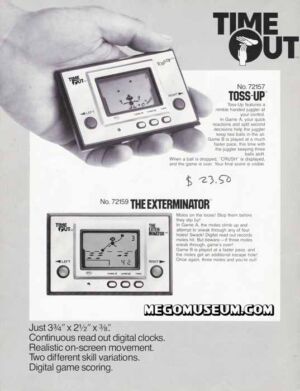Gaming historians preserve what’s likely Nintendo’s first US commercial
Gamers of a certain age may remember Nintendo’s Game & Watch line, which predated the cartridge-based Game Boy by offering simple, single-serving LCD games that can fetch a pretty penny at auction today. But even most ancient gamers probably don’t remember Mego’s “Time Out” line, which took the internal of Nintendo’s early Game & Watch titles and rebranded them for an American audience that hadn’t yet heard of the Japanese game maker.
Now, the Video Game History Foundation (VGHF) has helped preserve the original film of an early Mego Time Out commercial, marking the recovered, digitized video as “what we believe is the first commercial for a Nintendo product in the United States.” The 30-second TV spot—which is now available in a high-quality digital transfer for the first time—provides a fascinating glimpse into how marketers positioned some of Nintendo’s earliest games to a public that still needed to be sold on the very idea of portable gaming.
Imagine an “electronic sport”

Founded in the 1950s, Mego made a name for itself in the 1970s with licensed movie action figures and early robotic toys like the 2-XL (a childhood favorite of your humble author). In 1980, though, Mego branched out to partner with a brand-new, pre-Donkey Kong Nintendo of America to release rebranded versions of four early Game & Watch titles: Ball (which became Mego’s “Toss-Up”), Vermin (“Exterminator”), Fire (“Fireman Fireman”), and Flagman (“Flag Man”).
While Mego would go out of business by 1983 (long before a 2018 brand revival), in 1980, the company had the pleasure and responsibility of introducing America to Nintendo games for the first time, even if they were being sold under the Mego name. And while home systems like the Atari VCS and Intellivision were already popular with the American public at the time, Mego had to sell the then-new idea of simple black-and-white games you could play away from the living room TV (Milton Bradley Microvision notwithstanding).
The 1980 Mego spot that introduced Nintendo games to the US, now preserved in high-resolution.
That’s where a TV spot from Durona Productions came in. If you were watching TV in the early ’80s, you might have heard an announcer doing a bad Howard Cosell impression selling the Time Out line as “the new electronic sport,” suitable as a pastime for athletes who have been injured jogging or playing tennis or basketball.
The ad also had to introduce even extremely basic gaming functions like “an easy game and a hard game,” high score tracking, and the ability to “tell time” (as Douglas Adams noted, humans were “so amazingly primitive that they still [thought] digital watches [were] a pretty neat idea”). And the ad made a point of highlighting that the game is “so slim you can play it anywhere,” complete with a close-up of the unit fitting in the back pocket of a rollerskater’s tight shorts.
Preserved for all time
This early Nintendo ad wasn’t exactly “lost media” before now; you could find fuzzy, video-taped versions online, including variations that talk up the pocket-sized games as sports “where size and strength won’t help.” But the Video Game History Foundation has now digitized and archived a much higher quality version of the ad, courtesy of an original film reel discovered in an online auction by game collector (and former game journalist) Chris Kohler. Kohler acquired the rare 16 mm film and provided it to VGHF, which in turn reached out to film restoration experts at Movette Film Transfer to help color-correct the faded, 40-plus-year-old print and encode it in full 2K resolution for the first time.
This important historical preservation work is as good an excuse as any to remember a time when toy companies were still figuring out how to convince the public that Nintendo’s newfangled portable games were something that could fit into their everyday life. As VGHF’s Phil Salvador writes, “it feels laser-targeted to the on-the-go yuppie generation of the ’80s with disposable income to spend on electronic toys. There’s shades of how Nintendo would focus on young, trendy, mobile demographics in their more recent marketing campaigns… but we’ve never seen an ad where someone plays Switch in the hospital.”
Source link
